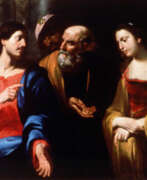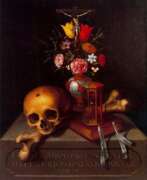Artists Tenebrism


Adam de Coster, born around 1586 in Mechelen and passing away in 1643 in Antwerp, was a renowned Flemish painter and a key figure among the Antwerp Caravaggisti. This group of artists was part of an international movement that interpreted Caravaggio's work in a personal manner, known for their genre scenes with strong chiaroscuro effects. De Coster was particularly celebrated for his nocturnal scenes, earning him the nickname "Pictor Noctium" (literal translation „Painter of Nights“) due to his preference for tenebrist scenes.
His works often depicted subjects similar to those found in Caravaggio's paintings, such as card sharps, fortune tellers, and musical performances, showcasing de Coster's fascination with the play of light and shadow. Notable pieces by de Coster include "Three Singers," which demonstrates his skill in rendering the texture of fabrics and the dramatic effects of light on his subjects, and "A Man Singing by Candlelight," capturing a moment's drama through meticulous lighting.
Adam de Coster's art continues to captivate audiences with its atmospheric intensity and meticulous attention to detail. His contributions have solidified his place in the history of Flemish painting, with works featured in prestigious collections, including the Liechtenstein Museum in Vienna and the National Gallery of Ireland.
For collectors and experts in art and antiques, Adam de Coster's masterpieces represent a fascinating intersection of Flemish tradition and Caravaggesque innovation. To stay informed about new discoveries, sales, and auction events related to Adam de Coster, consider signing up for updates from art galleries and auction houses. This will ensure you have access to the latest information and opportunities to appreciate the legacy of this luminous master of painting.


Orazio de Ferrari was an Italian artist, active in the Baroque period, born in Voltri, a suburb of Genoa. De Ferrari was a pupil of Giovanni Andrea Ansaldo. He was a member of the family of Genoese artists, with surnames de Ferrari, which also included Giovanni Andrea de Ferrari and Gregorio De Ferrari. During the 17th century, he painted murals in the chapel and many of the state rooms of the Royal Palace in Monaco.


Francesco Cairo, also known as Francesco del Cairo, was an Italian Baroque painter active in Lombardy and Piedmont. It is not known where he obtained his early training though he is strongly influenced by the circle of il Morazzone, in works such as the Saint Teresa altarpiece in the Certosa di Pavia. Many of his works are eccentric depictions of religious ecstasies; the saints appear liquefied and contorted by piety. He often caps them with exuberant, oriental turbans.


Tomas Hiepes was a distinguished Spanish painter from the Kingdom of Valencia, celebrated for his contribution to the Baroque movement. Hiepes specialized in still life and bodegón, a genre depicting pantry items, creating artworks that resonated both with private clients and public events. His career, particularly active from the second decade of the 17th century until his death, marks a significant period in art history, with most of his recognized works produced after 1642.
Hiepes' artistic mastery is evident in his depictions of everyday objects, fruits, particularly grapes, and flower vases, which became iconic in the Valencia region during the 17th and 18th centuries. His unique style of flower painting, focusing on the natural beauty and intricate details of his subjects, positioned him as a pivotal figure in art history. Museo del Prado hosts the most extensive collection of his works, highlighting his significance in the realm of Baroque art.
His works, such as "Still Life of Grapes" (1649) and "Still Life with Grapes" (1655), exemplify his skill in blending realism with the artistic flair typical of the Baroque period. These paintings not only showcase his ability to render subjects with stunning accuracy but also reflect his thematic versatility, ranging from religious motifs to allegorical representations.
For collectors and experts in art and antiques, Tomas Hiepes offers a fascinating insight into Spanish Baroque still life painting, with his works serving as a testament to the rich cultural and artistic heritage of the period. His legacy continues to inspire and captivate audiences, affirming his place among the celebrated artists of his time.
To stay informed about new discoveries, sales, and auction events related to Tomas Hiepes, consider signing up for updates from art galleries and auction houses. This subscription ensures access to the latest information and opportunities to engage with the works of this remarkable Baroque painter.


Jean Leclerc was a French painter known for his significant contributions to the Baroque art movement, particularly in the style known as tenebrism. Born and died in Nancy, Duchy of Lorraine, Leclerc is celebrated for his expertise in creating nocturnal light effects and the luminosity within his scenes. His education under the Venetian master Carlo Saraceni greatly influenced his artistic direction.
Although only a few authenticated paintings of Jean Leclerc's exist today, his legacy is also preserved through numerous etchings and engravings. His works, like "The concert," "The adoration of the shepherds," and "Doge Enrico Dandolo Recruiting for the Crusade," showcase his mastery in handling religious and historical subjects with a dramatic interplay of light and shadow.
For art enthusiasts and experts, Jean Leclerc's oeuvre offers a fascinating glimpse into the Baroque era's stylistic nuances and the broader tenebrist movement. His works are essential for understanding the artistic transitions and cultural dialogues of the 17th century in European art.
To dive deeper into Jean Leclerc's artistry and view some of his works, you can explore collections and detailed discussions on websites like the Yale University Art Gallery and the National Gallery of Art.
For collectors and art historians keen on updates related to Jean Leclerc's works or upcoming exhibitions featuring his art, subscribing to newsletters from reputable art galleries or museums can provide valuable insights and alerts on new discoveries, sales, and auction events connected to Leclerc's legacy.


Pietro Negri was an Italian painter who belonged to the Baroque "tenebrosi" movement.
Many of Negri's paintings have a somber character and convey a general mood of drama, which is emphasized by contrasting effects of light and shadow. This style is characteristic of Caravaggio and his followers. Negri painted allegories in the style of vanitas, scenes on mythological and religious themes, as well as domestic genre scenes.


Carlo Saraceni was an Italian painter, renowned for his contributions to the Baroque art movement. Born in Venice around 1579, Saraceni spent a significant portion of his career in Rome, where he was deeply influenced by the works of Caravaggio and Elsheimer. His art is celebrated for its vivid naturalism and meticulous detail, reflecting the stylistic transitions of early 17th-century Italian painting.
Saraceni's ability to blend Venetian colorism with Roman naturalism allowed him to create works that resonated with patrons across Europe, securing commissions from prominent ecclesiastical and aristocratic figures. His paintings, such as "Judith and the Head of Holofernes" at the Kunsthistorisches Museum in Vienna and "Saint Sebastian" at the Picture Gallery of the Prague Castle, showcase his mastery in depicting biblical and mythological scenes with emotional depth and realism.
Notably, Saraceni's work "The Dormition of the Virgin" was commissioned to replace a rejected painting by Caravaggio, indicating his stature and recognition in the artistic community of Rome. This commission highlights the nuanced differences in interpretation and representation of religious themes that distinguished Saraceni's approach from Caravaggio's.
Throughout his career, Saraceni remained connected to the vibrant artistic scene in Rome, engaging with the broader European context through his international relations. His legacy is preserved in the numerous works held in galleries and museums worldwide, reflecting his enduring influence on the Baroque art movement.
For art collectors and experts, Saraceni's oeuvre represents a pivotal moment in the transition of artistic styles, offering a rich tapestry of themes and techniques that continue to inspire and captivate audiences.
To stay updated on new product sales and auction events related to Carlo Saraceni's works, consider signing up for updates. This subscription is a great way to remain informed about opportunities to engage with the art and legacy of this influential Baroque painter.


Antonio Zanchi, a distinguished Italian Baroque painter, was renowned for his dynamic and emotionally charged artworks, primarily active in Venice from 1631 to 1722. Born in Este, Antonio Zanchi's artistic journey began under the guidance of Giacomo Predali and later Francesco Ruschi, which led him to Venice where he was deeply influenced by Tintoretto and the Roman painter Francesco Ruschi. His artworks are celebrated for their dramatic realism and effective use of chiaroscuro, embodying the Baroque's intensity and passion.
Antonio Zanchi's portfolio spans a variety of subjects, including religious and mythological scenes, that showcase his robust style and attention to emotional depth. Noteworthy works include his depiction of the Plague of Venice and the ceiling painting of the Crowning of the Virgin Mary with St. Girolamo Miani in Venice's Patriarchal Seminary. His influence extended beyond his lifetime, with pupils like Francesco Trevisani and Antonio Molinari carrying on his artistic legacy.
For collectors and art enthusiasts, Antonio Zanchi's works offer a glimpse into the Venetian Baroque's rich tapestry, reflecting the era's artistic vigor and complexity. His paintings, found in various Italian cities and even in Bavaria, continue to be revered for their compelling narratives and artistic mastery.
For those interested in staying updated on Antonio Zanchi's works and related events, subscribing for updates can provide valuable insights into upcoming sales and exhibitions, ensuring enthusiasts remain connected to Zanchi's enduring artistic influence.



